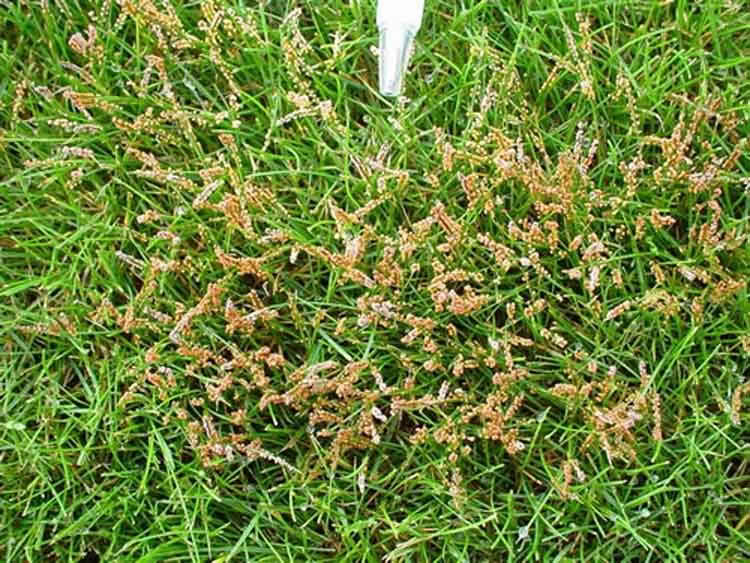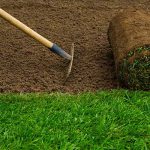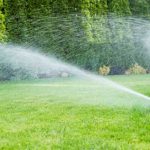Brown Patch is a relatively common disease whose causal agent is Rhizoctonia spp. and it can affect all turfgrass species during the summer months. The favourable conditions for its occurrence are warm humid weather patterns, particularly when soils are poorly drained and the sward is heavily thatched. As a result it is more commonly observed occurring on NZ Browntop or Fine Fescue lawns rather than ryegrass lawns. This disease shows as rapidly enlarging irregular or circular patches where the foliage turns purplish initially followed by a light brown colouration. Occasionally the turf will recover in the centre of the effected area and this will result in the appearance of a ring of diseased turf.
Disease Control
Brown Patch
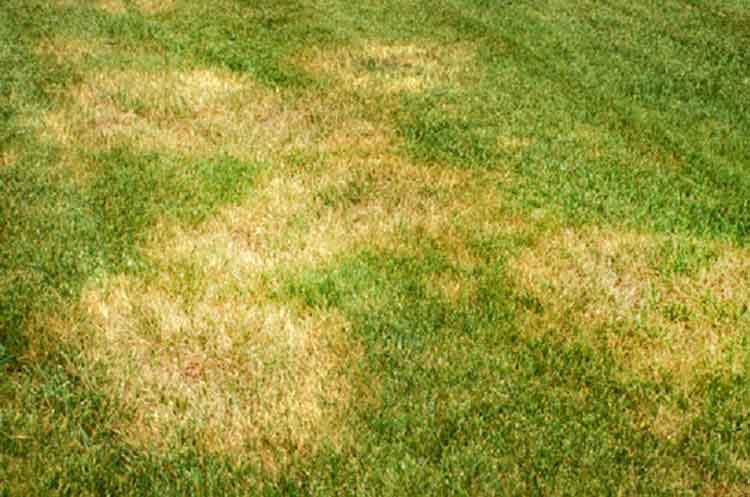
SOLUTIONS
Prevention is best effected by applying a systemic fungicide such as Taratek. De-thatch the lawn in autumn to assist prevention and address any drainage issues.
Dollar Spot
The causal agent for Dollar Spot is Sclerotinia homoeocarpa and all turf grass species can be affected. The favourable conditions for this disease which is a common occurrence in the top half of the North Island are when the plant leaves are wet for extended periods of time particularly from mid-spring until autumn. The symptoms are numerous small bleached spots which may coalesce to form large irregular patches. These spots may vary is size from the size of a 50c coin up to 50mm. Recovery is usually rapid as the roots are not affected. The disease affects most turf grass species but turf containing bent grasses like NZ Browntop and creeping fescues are most susceptible whereas Tall fescue appears to be resistant. Conditions such as drought, thick thatch build up and low fertility favour the establishment of Dollar Spot. The fungus also favours heavy compacted soils with high pH.
In the first instance apply a nitrogenous fertilizer such as Turf Supreme at 35gms/m2 or 3.5kgs per 100m2. Ensure that this fertilizer is applied prior to impending rain, during rain or alternatively water the lawn thoroughly after application.If conditions persist then a fungicide application such as Taratek may be required but this would be rare. Other treatments that are benficial include reducing the pH by the application of acidic fertilisers, dethatching and oversowing with more resistant species.
Fairy Rings
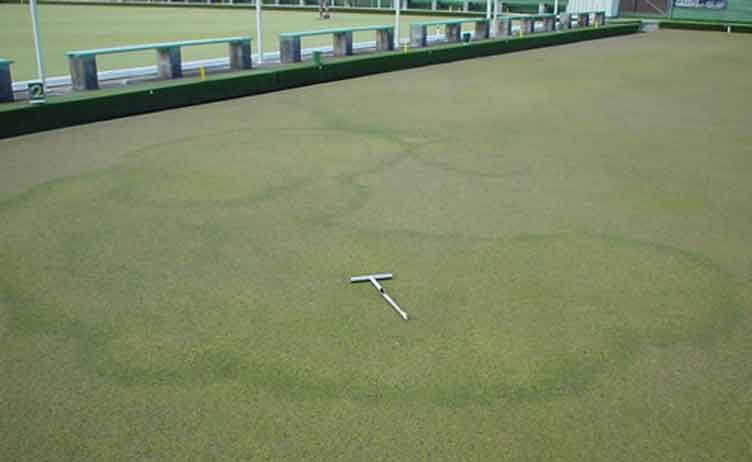
The causal agent of this relatively common disease is fungi related to the Basidiomycete species. This disease is obvious by the rings, circles or arcs of stimulated turf growth. Most typically these will be accompanied by the appearance of mushrooms or fruiting bodies in the second stage of the infestion. It is most commonly observed on sandy soil types and on older, established and thatched lawns. In occurs more often in summer particularly when the fertilizer regime is either poor or non existent and in the presence of large amounts of decomposing organic matter. For this reason it is more commonly observed on older NZ Browntop lawns that have not been dethatched.
Apply a balanced fertilizer such as Turf Gold applied at 35mgs/m2 or 3.5kgs per 100m2Increase watering frequency. De-thatch the lawn in autumn. Typically, Fairy rings cannot be controlled using fungicides
Crown Rust
The causal agent for Crown Rust is the plant pathogen Puccinia coronata. and it affects both ryegrasses and Kentucky Bluegrass. It can occur at any time of the year but tends to be most common from early summer to late autumn particularly in mild, humid weather conditions. The affected turf appears rust coloured due to the production of numerous yellow or orange spores on the leaf. It is most particularly seen on low fertility soils where ryegrass lawns in autumn during dry conditions and in the absence of irrigation
Often these spores can be easily detected on footwear when walking across an infected lawn.
SOLUTIONS
Apply a nitrogen rich fertiliser such as Turf Supreme at 35gms/m2 or 3.5kgs per 100m2. Ensure that this fertilizer is applied prior to impending rain, during rain or alternatively water the lawn thoroughly after application.Increase the water application after application.Mow more frequently
Fusarium
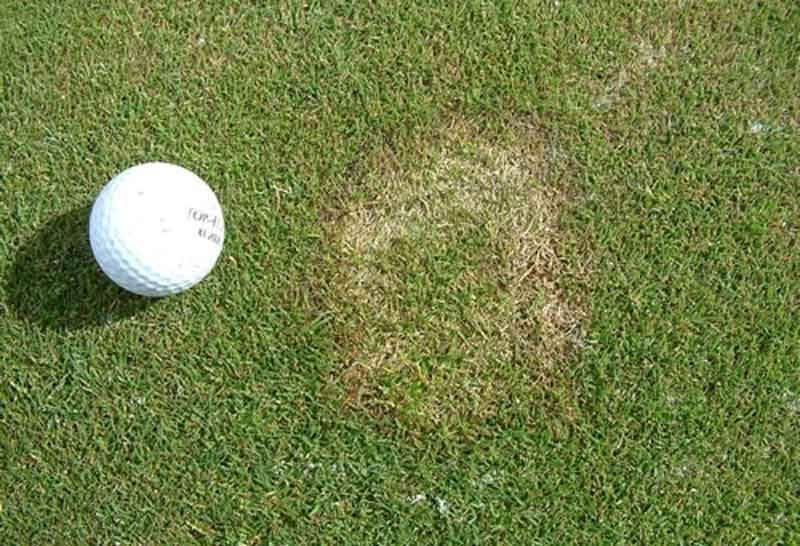
The causal agent of fusarium is Microdochium nivale and most cool season grasses can be affected, particularly during periods of cool, humid weather in late autumn. It is seen as very rapidly developing circular patches of 25-50mm in size and the leaves become brown and mushy. Tan blotches are first observed on the tips of leaves. It is more prevalent in established lawns that are burdened with large amounts of thatch.
The formation of this disease is discouraged by high levels of sulphate and potash as well as acidic conditions. A balanced fertilizer regime such as regular applications of Turf Gold fertilizer therefore is generally effective against the establishment of Fusarium.Apply this product every 10 -12 weeks at 25gms/m2 or 2.5kgs per 100m2.De-thatch the lawn in autumn
Melting Out
The causal agent for Melting Out and Leafspot is a group of fungii that includes Drechslera spp & Curvularia spp. It can affect all grass species but turf when close mown is more susceptible particularly in high nitrogen fertiliser regimes. The causal fungi usually first invade the leaves, producing small brown spots. As the disease worsens, the spots on leaf blades expand and produce a dark purplish-red oval border around a tan center. The spots enlarge until the entire width of the leaf blade is blighted. The leaf-spotting or leaf-blighting phase is less damaging to the turfgrass than is the melting–out (crown and root-rot) phase of the diseases. In melting–out, the crowns and roots are damaged, causing severe thinning of the turf. The problem is exacerbated by the addition of nitrogen fertilisers.
Avoid high applications of nitrogen. Fungicides to be effective must be employed during the leaf spot phase. Once the disease has moved into the melting out phase applications of fungicide will have limited effect. Contact the office for advice on the appropriate fungicide.
Red Thread
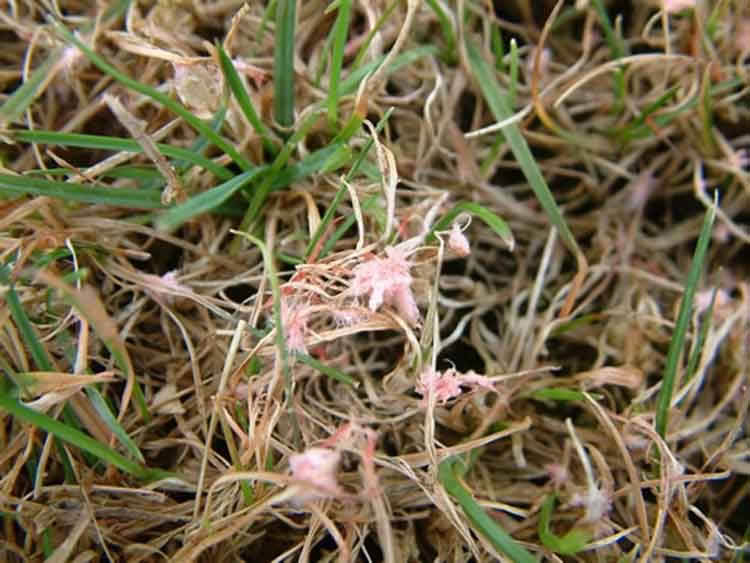
The causal agent for red thread or pink patch is Laetisaria fuciformis and Limonomyces spp. It is generally noticed as brown patches appearing in the lawn. Closer inspection particularly at the outer edges of these brown areas will reveal the characteristic red threads of mycelium growth. This is the most common disease exhibited on lawns comprised particularly of ryegrass or fine fescue, however, it can affect all other turf species. It is primarily a function of nitrogen deficiency and can occur at any time of the year, but tends to be more common from autumn until spring when consistently moist leaf blades provide ideal conditions for its propagation. It can be very site specific particularly in areas that are well sheltered or shady. Red thread can be prevalent on new sites particularly when the topsoil has been removed and replaced. The base saturation fertility level on these soils is low and as a result the plants struggle to uptake sufficient nitrogen to meet their requirements. It can take some time to build this fertility back to desirable levels. Therefore, during this period of time a regular balanced fertilizer regime is recommended.
Apply a nitrogen fertilizer such as Turf Supreme at 40gms/m2 or 4.0kgs per 100m2. Follow up with an application of Turf Gold in 3 weeks time at a rate of 35gms/m2 or 3.5kgs per 100m2. Thereafter continue applications every 8 -10 weeks until the problem abates. As the soil fertility increases the likelihood of a red thread outbreak will decrease, however, this may take some time to occur particularly on sandy soils or soils containing low levels of organic matter. Ensure that mower blades are sharp to provide a clean cut to the leaf blades, because leaf exudates formed at mowing wounds form favourable media for spore germination and mycelial growth. Restrict foot traffic on the lawn until symptoms desist. If irrigating or watering the lawn ensure that this occurs in the morning rather than the evenings. If conditions persist then a fungicide such as Taratek or Chlorotek should be applied at label rates. This should generally take place as two applications 14 days apart. Thereafter continue with the regular nitrogenous fertilizer applications.
Slim Moulds
The causal agents for this disease include many Basidiomycete spp. It is generally seen in winter when cool and wet conditions promote the formation of fruiting bodies. The fruiting bodies can of various colours but are most commonly grey purplish-brown or white. They are easily rubbed off by finger.
This is generally only a temporary condition and symptoms quickly disappear in dry weather.
